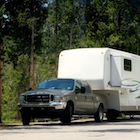Brake with confidence
Brake safely and with confidence
At our shop during the RV season, we see quite a few customers who have either grabby brakes or no brakes at all on their RVs when stopping or attempting to stop. Many times a short lesson on brake control set-up and a test ride will send them safely back on the road with a minimum service charge.
A brake control has a primary function that requires the unit to regulate the amount of amperage applied to the trailer brake magnets. It is this amount of output or modulation that controls the reaction to the driver applying the foot brake pedal on the tow vehicle in any stopping situation—whether normal or in an emergency stop.
The brake control will usually be installed in the lower dash area, within reach of the driver. Some late model trucks and SUVs will have an option that provides an integrated brake control installed into the vehicle’s dashboard.
Most commonly the brake control will be receiving its power supply from a designated power source, located in the fuse panel via an OEM or aftermarket electric brake harness adapter kit.
Types of braking systems
There are units that are electric/hydraulic, and this type of set-up will not work in conjunction with anti-lock brake systems (ABS) found on most all late model trucks and SUVs today.
There are three different types of brake controllers, with a common feature allowing the driver to manually override the brake control and apply the trailer brakes by moving a lever or pushing a button. The minimum low current will be about 1 to 1 ¾ amps, and the maximum amount depends on the size and number of brake magnets on the trailer. Each magnet will draw about three to four amps.
A time-based control will generate a preset output signal over a period of time. They are not proportional to the pressure applied to the brakes—and this type of unit can be mounted at any angle. This control may not be as common as other units but is well suited for single axle trailers with electric brakes.
An inertia-activated or proportional brake controller offers a smooth response in many different stopping situations. This control will have an internal sensing device or pendulum that senses the tow vehicle’s rate of deceleration, and applies amperage to the trailer brakes at the same rate.
In the case of the more advanced technology found in accelerometer brake controls, the braking rate will still be proportional, but the signal to apply the brakes is provided by a microprocessor rather than a pendulum. These controls do not require the levelling adjustment procedure found on other controls, and can be found with digital and diagnostic displays.
Keep it safe
It is very important to you, your family and other folks on the highway that you fully understand and utilize the proper set-up procedures and operation features of your brake controller. At best, improper operation can put excessive stress on the tow vehicle brake system by overheating the brakes, which can cause brake fade or complete failure—especially on the long downhill stretches found on many highways in British Columbia. It can also be noted that the application of the manual override can help with trailer sway caused by a crosswind or a passing tractor trailer, but can be hazardous on wet or icy roads. Just ask a trucker about this issue and you may hear a story or two. Be cautious and aware of all situations.
When a brake controller has been installed in your tow vehicle, check to ensure the installer or dealer has provided you with the operational manual. If possible, have the installation technician give an explanation of the functions and set-up procedures. Many RV dealers will provide this service as part of a new trailer orientation.
It is also important to check the connections at both the trailer plug and the tow vehicle plug to ensure they are clean and corrosion-free at the plug blades. A good quality dielectric grease applied to both surfaces will be beneficial.
Whether you are towing a single-axle tent trailer or a tri-axle toy hauler, you will brake safely and with confidence when you fully understand the purpose and set-up procedures of your brake controller.



